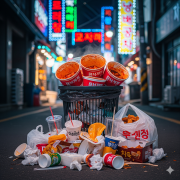The Environmental Impact of Korea’s Late-Night Eats
People get together late at night to eat hot stews and street snacks. Gangnam Jjim-o (강남쩜오) festivals put the Seoul streets in the light. These midnight snacks not only help us to satisfy hunger, but also raise questions such as waste, energy use, and environmentally friendly living. Due to its popularity, this is a significant portion of Korean nightlife. How can we fix street food to be more environmentally friendly, as well as friendly to us?
The Environmental Impact of Night Market Food Culture in Korea
The following problems could arise as a result of Korean nightlife:
Waste and Disposable Packaging
 For ease of use, street merchants often employ styrofoam and single-use plastics. The mass of landfills and marine pollution is greatly increased by these materials, which are extensively utilized in pojangmacha settings. There are still manufacturing and disposal issues with biodegradable alternatives, such as paper and biodegradable polymers.
For ease of use, street merchants often employ styrofoam and single-use plastics. The mass of landfills and marine pollution is greatly increased by these materials, which are extensively utilized in pojangmacha settings. There are still manufacturing and disposal issues with biodegradable alternatives, such as paper and biodegradable polymers.
Pre-Dark Energy Consumption
Because the neon lights attract visitors and the gas burners keep the rice cakes warm, late-night food dealers stay open until extremely early in the morning. When you cook and leave the lights on all the time, you let off a lot of carbon dioxide. This is why you should really think about choosing energy-efficient light bulbs and ecological energy sources.
Increase the Sustainability of the Supply Chain
Many dealers at night rely on fresh supplies that are brought in every day, which uses more fuel and pollutes the air. We can benefit the environment and cut down on pollution from transportation by supporting local sourcing programs like community-supported agriculture or urban farming partnerships.
Late-Night Meals that are Better for the Environment
Here are some ways that Korean nightlife could help keep the world habitable:
Sustainable Improvements in Packaging
Food sellers in the market who sell on the street could start using containers that can be reused or at least offer discounts to customers who bring their own. Getting people to use fewer single-use products can be sped up with incentives, like giving discounts to people who bring their own bowls.
Energy-Saving Stalls
To reduce energy usage, pojangmacha can be retrofitted with LED lights and high-efficiency burners. For heating equipment that is either solar-powered or provided by the grid, vendors can look at shared charging stations.
Addressing the Needs of the Community
A ‘zero-waste night market,’ composting stations, or nightly garbage collection efforts may be piloted by local governments and NGOs working together. Promoting sustainable behavior change over the long run is possible through vendor and consumer education on mindful consumption.
The Sustainable Nightlife
Creating awareness among people about the environment will help to preserve the legacy as well as the ecosystem of the street food culture in Seoul. Another good read is the article titled “Benefits of Writing About the Environment,” where you will find out how writing about the environment can help spread the message and persuade people to do good things for the surrounding. Because of this, it might help make Korea’s street food scene better for the environment and lessen our total effect on the world.
Conclusion
Korea’s night markets will be around for a long time. When you look past the bright sign, street food is more than just a quick snack. It’s the heart of a culture. Gangnam Jjim-o and its tasty friends will be around for a long time because we use eco-friendly packaging, save energy, and work with the community.

